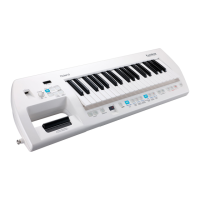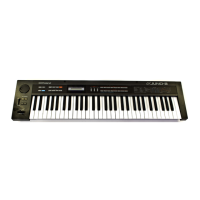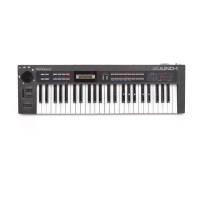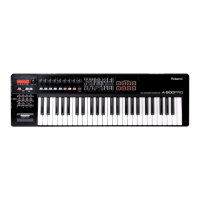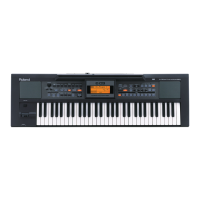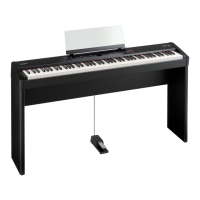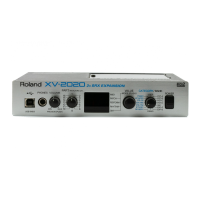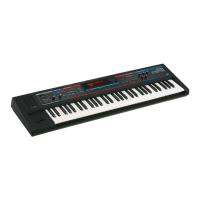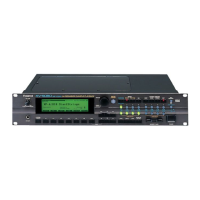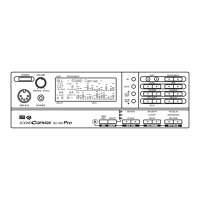MFX/IFX Parameters
47
20 SLICER
By applying successive cuts to the sound, this effect turns a
conventional sound into a sound that appears to be played as a
backing phrase. This is especially effective when applied to sustain-
type sounds.
You can use MFX CONTROL to restart the step sequence from the
beginning (p. 10).
L in L out
R outR in
Parameter Value Explanation
Step 01–16 0–127 Level at each step
Rate Sync
(Rate (sync switch))
OFF, ON
If this is ON, the rate synchronizes with
the tempo of the rhythm.
& “Tempo” (p. 8)
Rate Hz (Rate (Hz)) 0.05–10.00 [Hz]
Rate at which the 16-step sequence will
cycle
Rate Note
(Rate (note))
Note
& “Note” (p. 72)
Attack 0–127
Speed at which the level changes
between steps
In Sync Sw
(Input Sync Sw)
OFF, ON
Specifies whether an input note will
cause the sequence to resume from the
first step of the sequence (ON) or not
(OFF)
In Sync Thre
(Input Sync Threshold)
0–127
Volume at which an input note will be
detected
Mode LEGATO, SLASH
Sets the manner in which the volume
changes as one step progresses to the
next.
LEGATO: The change in volume from one
step’s level to the next remains unaltered.
If the level of a following step is the
same as the one preceding it, there is no
change in volume.
SLASH: The level is momentarily set to
0 before progressing to the level of the
next step.
This change in volume occurs even if the
level of the following step is the same as
the preceding step.
Shuffle 0–127
Timing of volume changes in levels for
even numbered steps (step 2, step 4,
step 6...).
The higher the value, the later the beat
progresses.
Level 0–127 Output Level
21 ROTARY
This simulates a classic rotary speaker of the past.
Since the operation of the high-frequency and low-frequency rotors
can be specified independently, the distinctive modulation can be
reproduced realistically. This is most effective on organ patches.
L in
R in
L out
R out
Parameter Value Explanation
Speed SLOW, FAST
Simultaneously switch the rotational
speed of the low frequency rotor and
high frequency rotor.
SLOW: Slows down the rotation to the
Slow Rate.
FAST: Speeds up the rotation to the Fast
Rate.
Wf Slow
(Woofer Slow Speed)
0.05–10.00 [Hz]
Slow speed (SLOW) of the low frequency
rotor
Wf Fast
(Woofer Fast Speed)
0.05–10.00 [Hz]
Fast speed (FAST) of the low frequency
rotor
Wf Accel
(Woofer Acceleration)
0–15
Adjusts the time it takes the low
frequency rotor to reach the newly
selected speed when switching from fast
to slow (or slow to fast) speed. Lower
values will require longer times.
Wf Level
(Woofer Level)
0–127 Volume of the low frequency rotor
Tw Slow
(Tweeter Slow Speed)
0.05–10.00 [Hz]
Settings of the high frequency rotor
The parameters are the same as for the
low frequency rotor
Tw Fast
(Tweeter Fast Speed)
0.05–10.00 [Hz]
Tw Accel
(Tweeter Acceleration)
0–15
Tw Level
(Tweeter Level)
0–127
Separation 0–127 Spatial dispersion of the sound
Level 0–127 Output Level
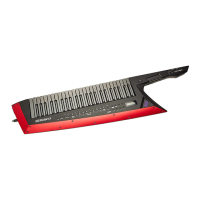
